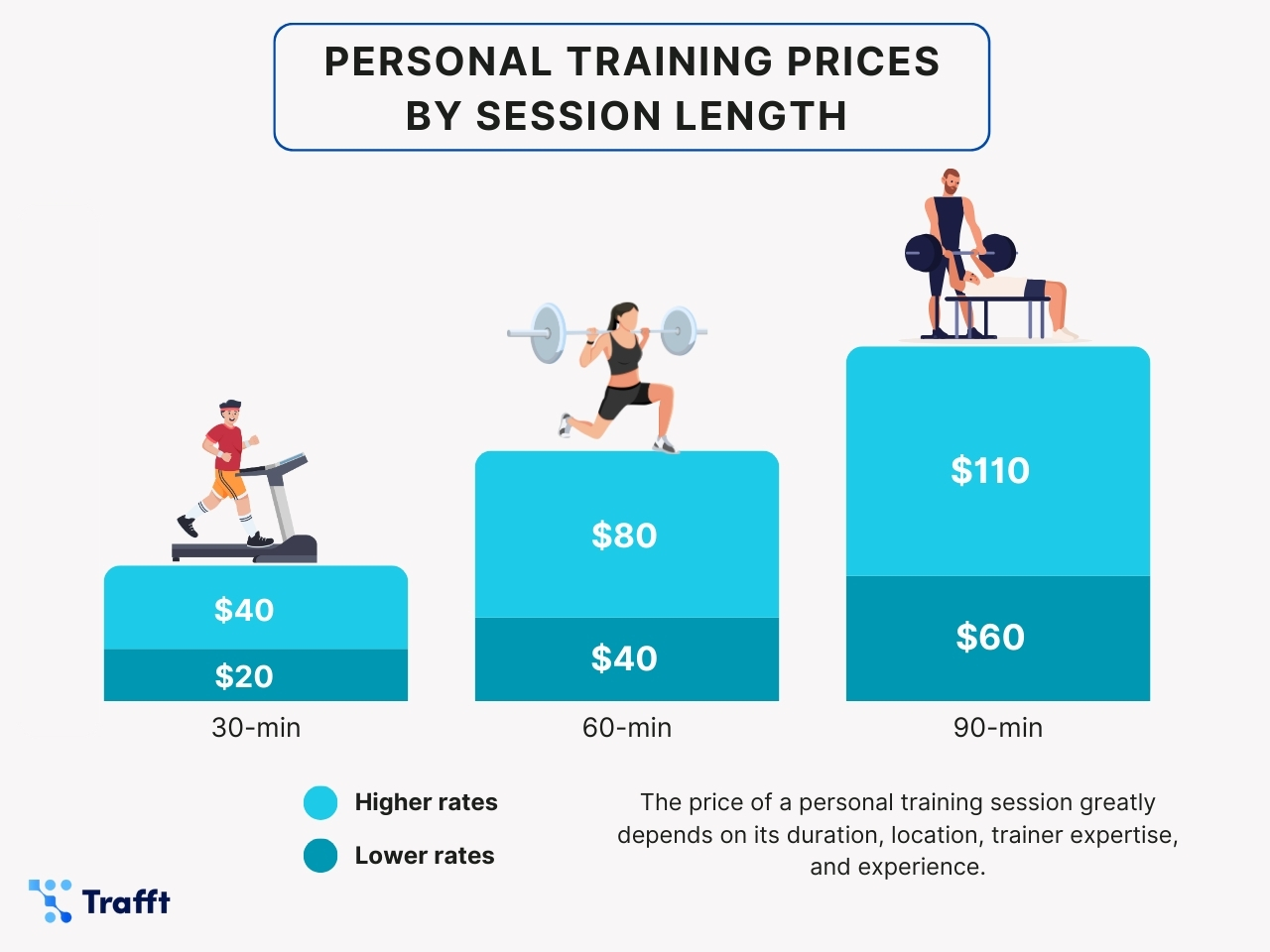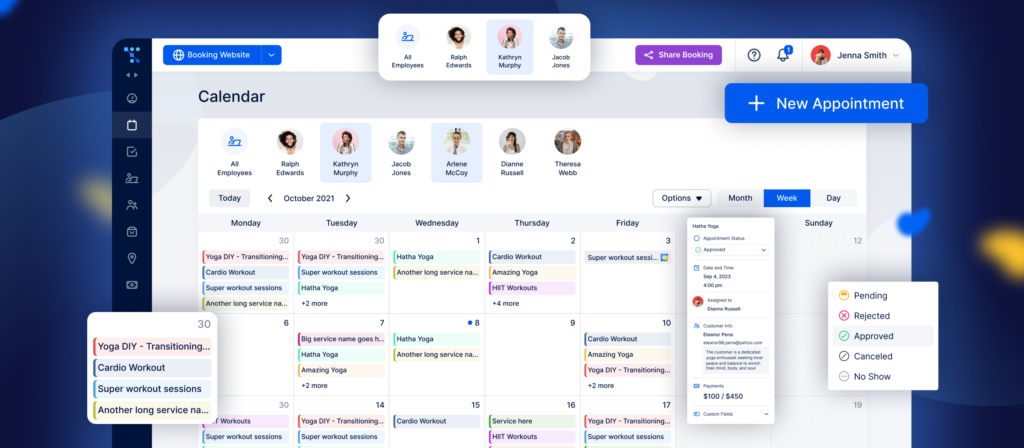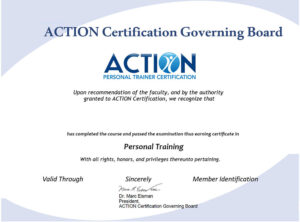Knowing how much to charge for personal training is a common challenge faced by new personal trainers and those building their own business in personal training services.
Personal training rates are different for those working in a fitness facility as an employee. The employer sets the price for your services, and you will earn a percentage from it as you conduct training sessions. However, for independent personal trainers, it's difficult to determine if you're overcharging your clients or getting paid less than what you deserve.
How much should you charge your clients for your services? There are no standard rules for how you should rate your training sessions. What most personal trainers do is conduct a little market research on other fitness programs near them and look at their personal training rates per hour. They get the average price list and set their price higher or lower based on their work experience.
Setting the right cost for your training sessions can be challenging, but knowing how much personal trainers cost as well as the factors to consider when deciding on a price will help you determine how much to charge for personal training.
How Much Do Personal Trainers Cost?

The national average cost of a one hour training session starts at around $40, some offer $60 per hour up to $70, with most pay around $55. But some personal training services can cost either $40 or $400 per session. It can be more expensive if clients are looking for long term packages such as weekly or monthly fitness programs.
Independent trainers can set the value of their own rate based on the market forces, which vary depending on where they operate. They could charge a little over $100 per session in highly urbanized cities or a little less than $60 per hour outside the city. However, if you plan on growing your client base, you should set the price lower so that more people can afford to pay for your services.
Start small, dream big. When starting out a business, it is normal to set low prices at the beginning. Affordable rates attract clients faster. You may begin with a $40 hourly rate and $20 for half a session. The value is reasonable and better than that of a commercial gym.
Once your business has expanded and established a bigger client base, that's when you start increasing the prices of your services. If your schedule is always full and the demand continues to grow bigger, raising your hourly rate to $60 or $80 and $30 to $40 for a half an hour session is acceptable.
Conveying the price increase to your clients can be a challenge. Communicate the new prices with your clients with confidence. You may explain to them the reason behind the increase and you must not waver in this, especially when it's a fair exchange. Customers always want to get their money's worth so if you're deciding on charging a higher rate, make sure the quality of your services has also improved.
To help you understand further how much value personal trainers should set per training session, you must know the factors that affect personal training rates.
What Factors Influence the Rate of a Personal Trainer?
Location
One of the contributing factors to your personal training rates is location. Where you operate your business makes a huge influence when pricing your services. Determine whether your area has a high or low cost of living.
According to the U.S. Bureau of Labor Statistics (BLS), fitness professionals earn more in the state of New York, Massachusetts, and Washington D.C. This may not apply to those who offer online fitness training sessions, but this means that you have to match your rate depending on your location.
Check the rates from other personal trainers and fitness studios in your area. You may go to their official website or social media accounts to know what type of services and packages they offer and how much.
Duration per Session

The length of time per training session normally lasts for an hour, but personal trainers also offer 30 and 90-minute training sessions that can be done daily, few days per week, or once a week. Some clients take longer sessions with few days of downtime for recovery, while some take shorter sessions every day.
Frequent short training sessions generate money faster. However, depending on your client's needs, you will have to determine the duration that works for you and your client.
Level of Coaching Experience
Remember that clients are paying for your expertise, meaning your years of work experience in the fitness industry. Thus, the more years of work experience you have as a personal trainer, the more you are allowed to increase your rate.
Your knowledge grows as you gain more experience. So if you have been a certified personal trainer for several years, you will have acquired enough skills and techniques to become more competent. You will use what you have learned in your previous experiences in formulating effective fitness programs.
More years in service is an advantage but that doesn't mean those who are starting out can't ask for an average rate. New personal trainers are still professionals, but they need to make sure that their rate measures up to their level of experience.
Capital Cost and Operating Expense

Image by rawpixel.com on Freepik
The most tangible factor to consider when setting the price for your personal training services is the financial cost of starting and then maintaining the business. This means you have to earn a decent amount of money to cover the daily operating expenses and generate profit at the same time.
Expenses include but are not limited to:
- Internet connection
- If applicable, electric and water utility bill and rent for commercial space
- Website development and maintenance
- Necessary fees for online fitness coaching such as premium membership or subscription to an online video conferencing platform
- Additional marketing and advertising expenses
- Office equipment such as computers, printer, software applications, and other hardware
- Office supplies like paper, pen, staples, etc.
- And, government taxes
List down all your possible expenses, big and small, including any debts; to know how much you have to earn to keep your enterprise.
Model for Delivering your Services
There are many models for how to deliver and offer your services. For example, you can set a fixed price per 60-minute session and then provide discounts when clients request training bundles, a similar concept to having a wholesale price. For instance, you may set a rate of $70 for a single training session and then offer a discounted price of $600 for 10 sessions, which induces a $100 savings for the clients as they will save $10 for every session.
Another model is to provide a customized service for every client. A highly personalized fitness program tailor-fitted to a client's needs should cost more than the regular services offered.
Your availability should also come with a price. Convenience and access are privileges and they should have value. Set a higher rate if you offer a 24 hour customer service and other exclusive access.
How Much your Clients can Afford
You will be dealing with people from different walks of life—senior citizens, at-risk students, celebrities. So, it is also important to consider the amount your clients are willing and able to pay for your services.
Personal trainers often ask if they should charge the same amount to all their clients. You may charge differently for personalized fitness programs, but keeping your personal training rates the same for all your clients makes billing and bookkeeping a lot easier.
Credentials as a Personal Trainer

If you are determined to become a personal trainer, there is one important thing that you must do before anything else, and that is to get yourself certified. You can get your credentials by taking National Commission for Certifying Agencies (NCCA) accredited certification programs such as the NSCA-CSCS (Certified Strength and Conditioning Specialist) and the NSCA-CPT (Certified Personal Trainer) from the National Strength and Conditioning Association (NSCA).
Getting these credentials is not only necessary for starting your own personal training services, but it also tells your clients that you are competent and have the necessary skills. Such validation gives them confidence and they can trust you will provide a suitably effective fitness plan.
Thus, consider the cost for certification when setting the rates for your services. Certified personal trainers have higher rates.
Pricing Structure
The pricing structure helps you set the price of your services according to their value. Your rate should reflect the number of benefits your clients receive from your services.
You may optimize your pricing structure by setting multiple price levels or have a one-price model. Having a one-price policy means charging all your clients the same price. Clients will not be able to negotiate or bargain with your price. It also means offering discounts on equal terms.
Having flexible pricing on the other hand enables your rate to adapt to certain factors, such as the client's goals and timeline. It allows you to charge a higher price should you incur other costs, like requests for in-home service. You may include the costs for travel and other miscellaneous in your price when going to your client's location.
From setting a variable price, you can also create a bundle of sessions for a certain price. You may offer packages with tiered pricing where they can renew when they run out of sessions. You can also create a subscription plan that automatically renews either monthly or annually.
Get more bookings with the right tool for the job
Staying organized has never been easier.
You can now manage your business and grow your brand with a single, powerful software that keeps all of your appointments in line, your clients organized and your business booming.
Trafft is the perfect personal trainer software for business owners who need to streamline their booking experience both for their staff and their clients.

Trafft handles everything for you, even sending automated email or SMS reminders to your clients. No-shows? Not anymore!
The Trafft booking software adapts to different industries for a blissful online booking experience and employee management.
Want to know more? Check out Trafft's awesome features to see what you are missing.
Tips on How to Get Paid Correctly
Realize Your Worth
You have to believe in yourself before others do. Know your worth and believe in the value of the services you provide. Be confident to set your price especially if the price reflects the quality of your services.
Manage your Client's Expectations
Establishing clear expectations from your clients is key to a stronger relationship. Ask what your clients expect from you as their trainer and what they expect from the program. Explain the services that you offer and be transparent on the processes therein, then ask them how much they are willing to pay.
If their expected cost fits your pricing structure, and if you think you can formulate a fitness program with such a price, you may proceed with the training. However, if the amount they're willing to pay is not profitable, you may have to pitch in your services to the clients again for them to further understand.
Increase your Value
Consumers always expect high value and quality on expensive products and services. Sometimes, people choose to pay more for better quality and convenience. Their willingness to pay depends on how much value a product or a service has. Thus, the greater value you provide in your personal training services, the more they are willing to pay.
Other than convenience, you can add more value to your services by considering its
- Exclusivity
- Timing
- Location
- Presentation
- Trends
You can also set a premium price for some of your services.
Highlight the Outcome
Don't just bundle your services and sell them into packages. Highlight what the clients will gain after completing their training sessions. Truth is, not all clients want to exercise, but they still do it because they are driven by the end result.
Thus, instead of simply selling a package of individual training sessions, market a fitness program that is specialized to achieve a specific outcome such as weight loss for a short-term activity and more.
To give an example, you can offer a fitness program that can help them lose weight in 6 weeks. Create a weight loss program that consists of two 60-minute strength-building training and one 30-minute cardio workout per week.
It will become a package of 12 one-hour training sessions and six half an hour sessions with a total of 15 hours. This weight loss program is much more valuable than a $600 fitness package of ten 60-minute training sessions that cost $70 each.
As for the pricing, you must keep the price point lower than $1000. You can set the price at $996 to create a perception of increased affordability.
Make Payments Automatic for Longer Commitment
Automatic payment is one way to maintain your number of clients. Manual and individual purchases make the clients less attached to the program, as they can just simply choose not to return.
A monthly subscription to a fitness program will make them think that it is a long-term commitment instead of a spur of the moment. Moreover, automating payments also enables you to estimate earnings and manage income better.
FAQs about how much to charge for personal training
1. What factors should I consider when determining how much to charge for personal training?
It's vital to take into account a variety of aspects when figuring out how much to charge for personal training, including your experience and credentials, local demand for your services, the cost of facilities or equipment, and the services you provide.
You might also want to think about the prices of other local personal trainers.
2. How much do personal trainers typically charge per session or hour?
Depending on their level of experience, where they are located, and their area of expertise, personal trainers often bill between $50 and $200 for each session or hour. A personal training session typically costs about $75 per hour.
3. Is it better to charge per session or to offer package deals?
The needs of your customers and your business strategy will determine whether you should charge per session or provide package discounts. While some personal trainers prefer to bill by session, others discover that consumers prefer the convenience and financial advantages of package agreements.
4. How much should I charge for group training sessions?
Depending on the number of participants and the duration of the session, group training sessions might range greatly in price. During group sessions, trainers typically charge less per person than they would for individual lessons.
5. Should I charge more for specialized training programs or services?
Specialist personal training services or programs, such for sports-specific training or injury rehabilitation, may be more expensive than those for general personal training. Nonetheless, it's crucial to conduct market research and make sure your prices are reasonable.
6. How do I determine the market rate for personal training in my area?
Examine the fees charged by other trainers and gyms in your area to ascertain the going rate for personal training there. To learn more about what customers are prepared to pay for personal training services, you may also run surveys or focus groups.
7. What are some strategies for increasing my rates over time?
It may take time to gradually raise your rates. Every six to twelve months, or whenever you reach a particular milestone or degree of experience, you might want to consider introducing tiny price increases. Communicate the value of your services to your clients and be open and honest about rate hikes.
8. How can I communicate the value of my services to potential clients when setting my rates?
Potential customers can be convinced of the worth of your services by communicating this to them. Pay attention to the advantages of personal training, including enhanced health and fitness, specialized care, and accountability.
9. What is the average markup for personal training services at gyms or fitness centers?
Depending on the facility, the typical markup for personal trainer services at gyms or fitness centers can change. Personal training fees at some gyms may be marked up by 50% or more, whilst fees at other gyms may be lower or trainers may set their prices.
10. How can I balance setting a fair price for my services with making a profit as a personal trainer?
It can be hard to strike a balance between charging a fair price for your services and turning a profit as a personal trainer. Finding a price point that is both market-competitive and still enables you to pay your bills and make a respectable living is crucial. To appeal to a wider group of customers, think about creating several pricing tiers or packages.
Final thoughts on how much to charge for personal training
Deciding on how much to charge is never easy, however, these tips will give you an idea of how to do it the right way.
Ask their clients about what they want to achieve by taking the fitness program, and work on a plan that fits their needs. Communicate your services and prices properly. Be honest with your clients and set clear expectations from the very beginning.
Never sell yourself short just to attract more clients, especially if you know that you deserve more. Setting your price low in hopes of driving more profit isn't always good. It can also decrease your value. On the other hand, never overcharge your clients. Always make sure your value is worth the price they pay you. Setting your prices too high for poor quality of service leads to dissatisfied customers.
If you enjoyed reading this article about how much to charge for personal training, you should also check out this one on how to sell personal training.
We also wrote about similar topics like how to start an online personal training business, gym owner salary, gym mission statement examples, gym slogans, gym logo ideas, personal trainer certification, fitness hashtags to use on social media, and how much does a personal trainer makes.






